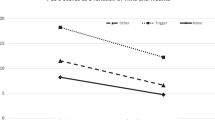Abstract
It is clear that sexual assault can precipitate posttraumatic stress disorder. Some theorists have suggested that less severe sexually harassing behaviors may also have trauma-like sequelae. In a study evaluating this hypothesis, 69 female participants completed self-report measures of instances of sexual harassment, basic beliefs, psychological distress/symptoms, and PTSD symptoms. Participants watched videotapes depicting sexual harassment, emotional arousal (not sexual in nature), and a neutral interaction while their heart rate was monitored, and they were interviewed using the SCID for PTSD. Results revealed that those who had been sexually harassed reported more negative basic beliefs, more general distress, and more negative state mood after watching the sexual harassment video, relative to those who had not been harassed. The severity of sexual harassing behaviors experienced was positively correlated with PTSD symptoms. Heart rate reactivity to the videotapes did not differ across groups defined by sexual harassment status.
Similar content being viewed by others
References
Blanchard, E. B., Hickling, E. J., Buckley, T. C., Taylor, A. E., Vollmer, A., & Loos, W. R. (1996). Psychophysiology of posttraumatic stress disorder related to motor vehicle accidents: Replication and extension. Journal of Consulting and Clinical Psychology, 64, 742–751.
Burnam, M. A., Stein, J. A., Golding, J. M., Siegel, J. M., Sorenson, S. B., Forsythe, A. B., & Telles, C. A. (1988). Sexual assault and mental disorders in a community population. Journal of Consulting and Clinical Psychology, 56, 843–850.
Calhoun, K. S., & Resick, P. A. (1993). Post-traumatic stress disorder. In D. H. Barlow (Ed.), Clinical handbook of psychological disorders (2nd ed., pp. 48–98). New York: Guilford Press.
Catlin, G., & Epstein, S. (1992). Unforgettable experiences: The relation of life events to basic beliefs about self and world. Social Cognition, 10, 189–209.
Cohen, J. (1988). Statistical power analysis for the behavioral sciences (2nd ed.). Hillsdale, NJ: Erlbaum.
Crull, P. (1982). Stress effects of sexual harassment on the job: Implications for counseling. American Journal of Orthopsychiatry, 52, 539–544.
Dansky, B. S.,& Kilpatrick, D. G. (1997). Effects of sexual harassment. In W. O'Donohue (Ed.), Sexual harassment: Theory, research, and treatment (pp. 152–174). Boston: Allyn & Bacon.
Derogatis, L. R. (1983). SCL-90-R manual II, Clinical Psychometric Research, Towson, MD.
Dougall, A. L., Herberman, H. B., Delahanty, D. L., Inslicht, S. S., & Baum, A. (2000). Similarity of prior trauma exposure as a determinant of chronic stress responding to an airline disaster. Journal of Consulting and Clinical Psychology, 68, 290–295.
Epstein, S. (1994). Integration of the cognitive and psychodynamic unconscious. American Psychologist, 49, 709–724.
Fitzgerald, L. F. (1990). Sexual harassment: The definition and measurement of a construct. In M. A. Paludi (Ed.), Ivory power: Sexual harassment on campus (pp. 21–44). Albany: SUNY Press.
Fitzgerald, L. F., Drasgow, F., & Gelfand, M. (1993). Sexual Experiences Questionnaire, Form E. Unpublished research scale. Department of Psychology, University of Illinois at Urbana-Champaign.
Foa, E. B. (1995). PDS (Posttraumatic Stress Diagnostic Scale) manual. Minneapolis, MN: National Computer Systems.
Foa, E. B., Riggs, D. S., Dancu, C. V., & Rothbaum, B. O. (1993). Reliability and validity of a brief instrument for assessing post-traumatic stress disorder. Journal of Traumatic Stress, 6, 459–473.
Frazier, P. A., & Burnett, J. W. (1994). Immediate coping strategies among rape victims. Journal of Counseling & Development, 72, 633–639.
Gutek, B. A., & Koss, M. P. (1993). Changed women and changed organizations: Consequences of and coping with sexual harassment. Journal of Vocational Behavior, 42, 28–48.
Janoff-Bulman, R. (1989). Assumptive worlds and the stress of traumatic events: Applications of the schema construct. Social Cognition, 7, 113–136.
Janoff-Bulman, R. (1992). Shattered assumptions. New York: The Free Press.
Kilpatrick, D. G., Resick, P. A., & Veronen, L. J. (1981). Effects of a rape experience: A longitudinal study. Journal of Social Issues, 37, 105–122.
Kilpatrick, D. G., Saunders, B. E., Amick-McMullan, A., Best, C. L., Veronen, L. J., & Resnick, H. S. (1989). Victim and crime factors associated with the development of crime-related post-traumatic stress disorder. Behavior Therapy, 20, 199–214.
Koss, M. P. (1990). Changed lives: The psychological impact of sexual harassment. In M. A. Paludi (Ed.), Ivory power: Sexual harassment on campus (pp. 73–92). Albany: SUNY Press.
Resnick, H. S., Kilpatrick, D. G., Dansky, B. S., Saunders, B. E., & Best, C. L. (1993). Prevalence of civilian trauma and PTSD in a representative national sample of women. Journal of Consulting and Clinical Psychology, 61, 984–991.
Rosenthal, R., & Rosnow, R. L. (1985). Contrast analysis: Focused comparisons in the analysis of variance. Cambridge: Cambridge University Press.
Shalev, A. Y. (1996). Stress versus traumatic stress: From acute homeostatic reactions to chronic psychopathology. In B. A. van der Kolk, A. C. McFarlane, & L. Weisaeth (Eds.), Traumatic stress (pp. 77–101). New York: Guilford Press.
Spitzer, R. L., Williams, J. B.W., Gibbon, M., & First, M. B. (1992). The Structured Clinical Interview for DSM-III-R (SCID), I: History, rationale, and description. Archives of General Psychiatry, 49, 624–636.
Valentiner, D. P., Foa, E. B., Riggs, D. S., & Gershuny, B. S. (1996). Coping strategies and posttraumatic stress disorder in female victims of sexual and nonsexual assault. Journal of Abnormal Psychology, 105, 455–458.
Watson, D., Clark, L. A., & Tellegen, A. (1988). Development and validation of brief measures of positive and negative affect: The PANAS scales. Journal of Personality and Social Psychology, 54, 1063–1070.
Wilcox, R. R. (1987). New designs in analysis of variance. Annual Review of Psychology, 38, 29–60.
Author information
Authors and Affiliations
About this article
Cite this article
McDermut, J.F., Haaga, D.A.F. & Kirk, L. An Evaluation of Stress Symptoms Associated with Academic Sexual Harassment. J Trauma Stress 13, 397–411 (2000). https://doi.org/10.1023/A:1007725022534
Issue Date:
DOI: https://doi.org/10.1023/A:1007725022534




